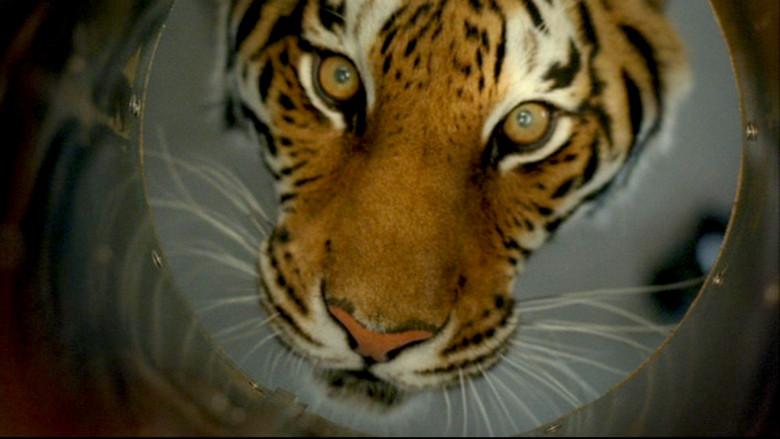
Burning Bright (Movie Review)
The title of Carlos Brooks’ 2009 thriller “Burning Bright” is an allusion to William Blake’s poem “The Tyger” written in 1794. Blake uses the title character of his poem to represent the enigmatic nature of God’s design. He poses a question that is likely as old as religion itself. That question being something along the lines of “How can a benevolent God create beings and creatures that seem to be configured for the execution of evil deeds?” Where William Blake’s poem simply presents a moral conundrum for the reader to consider, Brooks’ film seems to be more of the mind of angling towards an answer for the faithful.
“Burning Bright” tells the story of Kelly Taylor, a young woman whose mother has recently OD’d on pills leaving her and her 10 year-old autistic brother Tom in the care of her callous and self-centered step-father Johnny. Kelly’s college scholarship is on the verge of being pulled because she cannot find a suitable placement for Tom. The situation is compounded by the fact that Johnny has just used the money left for Kelly and Tom’s care to buy a killer circus Tiger. Johnny plans to use the snarling cat as the centerpiece of his exotic animal retreat. To make life a little bit grimmer for Kelly a powerful hurricane is blowing into town and she and Tom have been boarded up in the house to ride out the 120 mph winds. As the storm hits Kelly settles Tom in for the big blow-over and goes to sleep, at the same time Johnny pulls the Tiger cage into the living room to shelter the beast from the elements.
When Kelly awakens the hurricane is raging outside and she soon discovers that inside the new family pet is loose in the house. Kelly and her brother spend the better part of 24 hours trying to outwit the giant predator in their suddenly cramped two-story farmhouse. Meanwhile Johnny is passing the hurricane holed up in a bar downtown drinking himself into oblivion. As the storm creates chaos outside the house Kelly and Tom are quickly running out of places to hide within the besieged stricture.
Carlos Brooks does some really nice things with “Burning Bright”. There are two or three scenes with disconcerting intensity and suspense. There is also a rumbling tension throughout the cat and mouse 2nd act. In fact this film’s middle third is its most successful passage, making it one of the few films I’ve seen recently that defies the old cinematic wisdom that most scripts “fail in the second act”. The middle section of "Burning Bright" pulses with sufficient tension to make you forget the logic lapses, lack of atmosphere and stiffness in the performances that make much of the first act an uninspiring affair.
I have a sizable and often-stated problem with Christian horror films, some of this has to do with my distaste for heavy handed moralizing. The rest of my objection to films with a strongly Judeo-Christian ethic running through them is that they typically suck. Once more I make apologies to “The Sentinel”, “Jacob’s Ladder”, and “The Exorcist” if I am painting with too broad a brush. The fact of the matter is that those movies are all at least 20 years old and in that time the majority of Christian cinema has gotten cleaner, preachier and more monochrome in its message.
“Burning Bright” might have changed my mind for an evening had it not made a point to highlight certain character info, tread too lightly on the swearing and violence and provide a message of hope that requires a tidy ending. Like the three above examples of successful faith-based horror films this film is about a crisis of faith. It’s a compelling starting point; one that has some resonance for people of almost any spiritual orientation. Where this one fails me is that it proffers a resolution that feels like divine intervention for the righteous and a punitive fate for the wicked. Early on, Kelly has very human feelings about her plight in caring for Tom, and at first Johnny seems like a tortured, overwhelmed soul but one with only a modicum of malevolent energy. Sadly, by the end of the film Kelly has ‘chosen the right’, her autistic brother has had a “breakthrough” and step-dad is a serial douche bag committing the most heinous acts of evil out of pride and a weakness of spirit. In making these cheap, insufficiently tracked character choices Brooks sabotages the more complex emotions that he introduced earlier in the film and leaves us all thinking in black and white where cause and effect are concerned.
Perhaps the gravest flaw here is that the story was over-thought with regards to its significance as a spiritual struggle. I say this because when “Burning Bright” settles into the action of a man-eating Bengal Tiger trying to devour two kids in a house, it is pretty damned entertaining. There are some odd compositions, some questionable editing and some unfortunate compositing shots to reconcile; but Briana Evigan as Kelly uses her “Step Up 2” athleticism to great affect and as contrived as the whole concept may seem, the middle portion of the movie delivers on the trailer’s promise.
Like everyone I have often wondered how a benevolent deity can allow for the creation and existence of terrible people and things. I have also come to understand that the best way to deal with these things in the real world is to put out as much positive energy as I can and accept that resolutions seldom follow a traceable line of easy logic. If “Burning Bright” had been more confident in handing us a straight human drama based on this idea rather than a story that devolves into ultimate good and evil it would have been a recommendable film.

